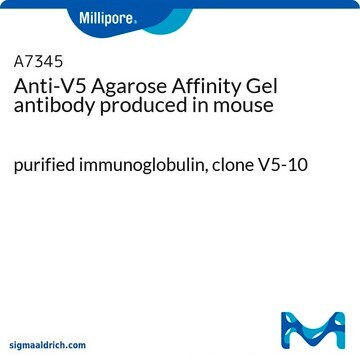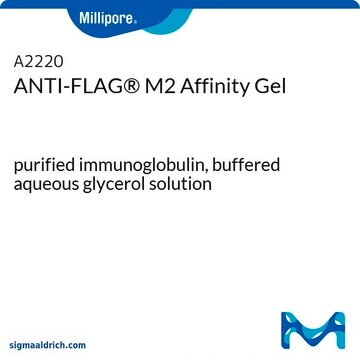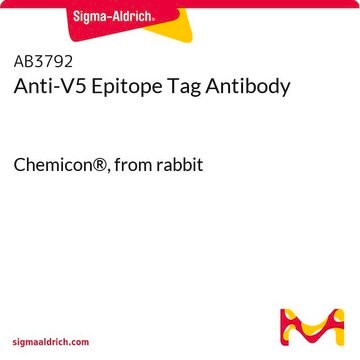The bead size for the V5 antibody ranges from 20 to 75 µm.
The affinity of the V5 antibody used (clone V5-10) has not been characterized. However, there is a relevant publication that contains this information for clone V5-10, which may serve as a useful reference:
- Title: HiBiT-qIP, HiBiT-based quantitative immunoprecipitation, facilitates the determination of antibody affinity under immunoprecipitation conditions
- Journal: Sci Rep. 2019 May 3;9(1):6895
- DOI: 10.1038/s41598-019-43319-y
- PMID: 31053795
You can access the publication at https://pubmed.ncbi.nlm.nih.gov/31053795/.
SAE0203
Anti-V5 Magnetic Beads
Magnetic agarose, Suspension
Synonym(s):
Anti-V5 Tag antibody produced in mouse, V5 Antibody, V5 Tag Antibody, V5 epitope Tag
About This Item
Recommended Products
General description
Application
Features and Benefits
- Beads are prepared with an affinity-purified anti-V5 antibody.
- Monoclonal Anti-V5 antibody is produced by fusing mouse myeloma cells and splenocytes from a BALB/c mouse.
- Protein-to-bead ratio is approximately 2 mg/mL.
Storage Class Code
10 - Combustible liquids
WGK
WGK 3
Choose from one of the most recent versions:
Certificates of Analysis (COA)
Don't see the Right Version?
If you require a particular version, you can look up a specific certificate by the Lot or Batch number.
Already Own This Product?
Find documentation for the products that you have recently purchased in the Document Library.
-
Do you have information about the affinity of the antibodies used for the V5 tag? Additionally, what is the bead size to which the V5 antibody is conjugated?
Do you have information about the affinity of the antibodies used for the V5 tag? Additionally, what is the bead size to which the V5 antibody is conjugated?
1 answer-
Helpful?
-
-
Anti-V5 Magnetic Beads (SAE0203-1ML) Can these beads be stripped and sanitized so that they can be reused for protein purification?
1 answer-
The binding capacity of these beads is 20-62 nmoles of V5-tagged fusion protein per 1 mL of settled resin. While the product may be reused, a protocol and the reuse capacity has not been determined. For reuse it is recommended to wash the resin thoroughly following elution. Please see the link below to review the product datasheet:
https://www.sigmaaldrich.com/deepweb/assets/sigmaaldrich/product/documents/275/574/sae0203pis-ms.pdfHelpful?
-
Active Filters
Our team of scientists has experience in all areas of research including Life Science, Material Science, Chemical Synthesis, Chromatography, Analytical and many others.
Contact Technical Service








